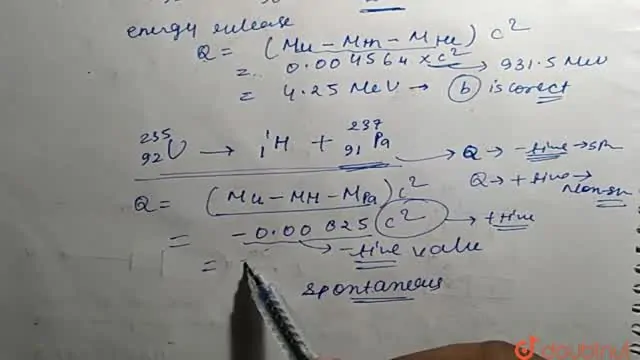We are given the following atomic masses:
.23892U=238.05079u.42He=4.00260u
.23490Th=234.04363u.11H=1.00783u
.23791Pa=237.05121u
Here the symbol Pa is for the element protactinium (Z=91)
(a) The alpha decay of .23892U is given by Eq. (13.20). The energy released in this process is given by
Q=(MU−MTh−MHe)c2
Substituting the atomic masses as given in the data, we find
Q=(238.05079−234.04363−4.00260)u×c2
=(0.00456u)c2
=(0.00456u)(931.5MeV/u)
4.25MeV.
(b) If .23892U spontaneously emits a proton, the decay process would be
.23892U→.23791Pa+.11H
The Q for this process to happen is
=(MU−MPa−MH)c2
=(238.05079−237.05121−1.00783)u×c2
=(−0.00825u)c2
=−(0.00825u)(931.5MeV/u)
=−7.86MeV
Thus,theQoftheprocessis¬ativeand∴itca∩otproceedspontaneously.Wewillhave→⊃plyane≠rgyof7.68MeV→a._(92)^(238)U nucleus to make it emit a proton.
Related Playlists
- BOOK - NCERT ENGLISHCHAPTER - NUCLEIEXERCISE - Exercise31videos
NUCLEI
- BOOK - NCERT ENGLISHCHAPTER - MOVING CHARGES AND MANGNETISM EXERCISE - Exercise28videos
MOVING CHARGES AND MANGNETISM
- BOOK - NCERT ENGLISHCHAPTER - RAY OPTICS AND OPTICAL INSTRUMENTSEXERCISE - Exercise32videos
RAY OPTICS AND OPTICAL INSTRUMENTS
Similar Questions
By using the following atomic masses : .23892U=238.05079u. .42He=4.00260u,.23490Th=234.04363u.
.11H=1.007834,.23791Pa=237.065121u (i) Calculate the energy released during the α−decay of .23892U.
(ii) Show that .23892U cannot spontaneously emit a proton.View SolutionConsider the following nuclear decay: (initially .236U92 is at rest)
.23692→.23290Th→X
Following atomic masses and conversion factor are provided
.23692U=236.045562u,
.23290Th=232.038054u,
.10n=1.008665,.11p=1.007277u,
.42He=4.002603u and
1u=1.5×10−10J
The amount of energy released in this decay is equal to:View SolutionShow that 23892U can not spontaneously emit a proton. Given:
23892U = 238.05079u, 23791Pa = 237.05121u 11H = 1.00783uView SolutionCalculate the energy released in MeV in the following nuclear reaction :
.23892U→.23490Th+.42He+Q[Mass of .23892U=238.05079u
Mass of .23890Th=234.043630u
Massof .42He=4.002600u
1u=931.5MeV/c2]View SolutionFind energy released in the alpha decay,
Given _92238U→23490Th+42He
M(_92^238U)=238.050784u<br>M(_90234Th)=234.043593u
M(_2^4He)=4.002602uView SolutionAlpha decay of .23892U forms .23490Th. What kind of decay from .23490Th produces .23484Ac ?
View SolutionCalculate the energy released in the following nuclear reaction:
21H+21H=42He
Mass of 21H= 2.01419u, Mass of 42He=4.00277uView SolutionYou are given that mass of 73Li=7.0160u,
Mass of 42He=4.0026u
and Mass of 11H=1.0079u
When 20 g of 73Li is converted into 42He by proton capture , the energy liberated , (in kWh) , is :
[ Mass of nucleon = 1GeV/c2)]View SolutionPart of uranium decay series is shown
.92U234→.90Th234→.91Pa234→.90Th230→.88Ra226
How many parts of isotopes are there in the above seriesView SolutionOne gm of each .1H1,.8O16,.6C14,.92U238 have-
View Solution


